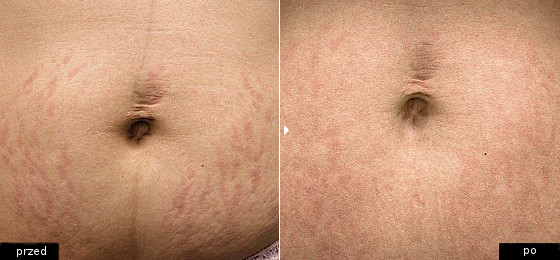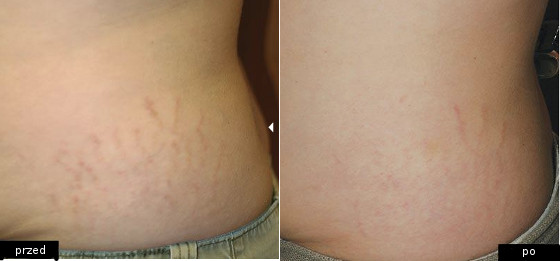Stret chmarks removal
Stretch marks (striae distensae) are parallel, spindle bands of thinned, wrinkled skin, initially elevated, edema, then undergoing atrophy. Their appearance is usually asymptomatic but can be combined with a gentle sensation of pruritus, less burning and pain.
Stretch marks are formed at the level of the dermis, and their formation is associated with impairment of fibroblasts, or cells responsible for the production of 2 types of proteins: collagen and elastin. These proteins are fibrous in form, creating an ordered network and giving the skin elasticity, firmness, flexibility and proper tension.
The evolutionary phases of stretch marks:
1) in the phase I - inflammatory phase, the inflammatory component, the pseudo-hypertrophic component prevails, the red, red or red-blue stretch marks are arranged in parallel. At this stage, we still have the best chance of getting rid of them.
2) in phase II - atrophic, there is an apparent regeneration of stretch marks. The red bands are brightened and reduced. This is due to attempts to regenerate the broken network of collagen fibers and thin elastin fibers. Because there is no possibility of restoring the skin condition before the cavity has occurred, as a result, white stripes appear on the skin that are palpable when touched. Joining the treatment of stretch marks at this stage may slightly improve the condition of the skin, but it will not be eradicated in 100%.
Location of stretch marks:
Stretch marks are usually bilateral, i.e. appear on both sides of the body, in every area of the body except for face, hands and feet. On the stomach they can have a radiant or fan-shaped appearance, on the hips transverse, on the breast radius from the nipple, while in the lumbo-sacral region they are horizontal.
1) In women this disease occurs twice as often as in men, it can occur at any age, although most often during puberty and pregnancy. The most common areas of stretch marks are hip girls, upper thighs, and breasts,
2) In men - the sacro-lumbar region, in the men, who train - shoulder girdle;
Causes of stretch marks:
1) Increased levels of cortisol (adrenal cortex) in the blood - causes impairment of fibroblast functions that start to produce altered collagen and elastin fibers: more brittle and less susceptible to stretching. During excessive stretching of the skin (eg during pregnancy, maturation, obesity, excessive sudden weight increase), there is a breakage of a regular network of fibers, which results in stretch marks. Because at the same time thinning of the epidermis layer also occurs, they become more visible,
2) Increased level of estrogen (during pregnancy, when using hormonal contraception) contributes to some extent to increase the possibility of stretch marks,
3) The use of drugs containing glucocorticoids (eg in the course of endocrine, allergic and autoimmune diseases) contributes to for thinning the epidermis, inhibiting collagen synthesis in the dermis and degrading existing collagen fibers,
4) Incorrect, low in nutrients (vitamins, micro- and macroelements) diet. The insufficient amount of zinc plays an important role here,
5) Genetic tendencies - it is likely that if there are stretch marks in the mother, they may also appear in her daughter;
Predisposition to the occurrence of stretch marks:
- obese people,
- teens in puberty,
- women during pregnancy, menopause,
- bodybuilders ,
- people with frequent weight fluctuations (also during stretch weight loss, stretch marks can be obtained),
- people repeatedly on low-calorie diets,
- people taking steroid drugs,
- people with genetic predisposition;
Prevention:
- avoiding frequent fluctuations in weight and "miraculous" diets,
- proper diet, providing sufficient doses of vitamins (mainly A, E, PP, B5) and micronutrients (especially zinc and silicon), or supplementation of these ingredients in ready-made medicinal preparations,
- local application of creams, gels, oils and plant-based preparations, elastin, collagen, biostimolines, vitamins, placental preparations, acetazolamides, alpha-hydroxy acids, etc. Collagen precursors such as proline linoleate, hydroxyproline complex and others are also present in local preparations. The type of cream is not so important, moisturizing / greasing the skin and massage is more important,
Important ingredients of cosmeceutics:
a) extracts from Centella asiatica - source of phytoestrogens stimulating collagen synthesis,
b) soy extracts - antioxidant, anti-inflammatory, stimulate fibroblasts,
c) silicon compounds (silanols) - promote the regeneration of collagen and elastic fibers, fight free radicals,
d) sodium pyruvate - stimulates the activity of fibroblasts,
e) lactic acid - reduces the keratosis of the epidermis,
f) vitamins A, C, E- antioxidant properties
In the case of intense exercise, you should prepare them individually and match the type of figure, age and advancement in training. Physical exercises must be progressive; avoid long-lasting and strong muscle cramps. The combination of moderate sports activity and massage improves vascular and lymphatic microcirculation and may be useful for toning the tissues;
Treatment:
This is the latest generation laser system for skin regeneration and rejuvenation. Fraxel laser does not uniformly illuminate the surface of the skin, but it "punches" it with thousands of microscopic laser "needles". The fragmentary (fractional name of the method), microscopic lesions (MTZ-microthermal treatment zones) of the skin, caused by the heating of tissues are created. Laser impulses penetrate the skin at a proper distance so as not to cause burns but effectively stimulate the skin proper for regeneration.
Postoperative effects: removal of stretchmarks - Fraxel laser


Chemical peel with the use of glycolic acid
Glycolic acid, at low concentrations, reduces the cohesion of corneocytes, reducing the thickness of the corneum. In high concentrations, on the other hand, it causes keratinocyte detachment and epidermolysis, stimulates the production of new epidermal cells and synthesis of collagen fibers in the surface layer of the dermis. Therefore, in repeated therapies it causes thickening of the dermis and epidermis.
Regeneruje i uelastycznia skórę, pobudza krążenie, pobudza produkcję kolagenu i elastyny. procedure jest bezpieczny i bezbolesny, polega na mechanicznym złuszczaniu warstw naskórka specjalnym aparatem, który ściera i wysysa starte komórki. procedure nie wymaga rekonwalescencji. Można łączyć z peelingiem kwasem glikolowym lub TCA.
Injecting specially formulated cocktails of various substances into damaged tissues to induce a fibroblast response in the dermis with collagen regeneration. Can be combined with a peel glycolic acid.
Other methods
Pharmacological treatment - retinoids (tretinoin - eg Retin A) - normalize the process of keratosis, affect the inflammatory processes in the skin, prevent the degradation of collagen, stimulate fibroblasts to collagen synyease,,
Dermabrasion - uses a device similar to a dental drill. The rotating camera head is covered with fine, sharp elements that rub the surface of the skin. Treatments are performed by plastic surgeons under general or local anesthesia, depending on the extent and depth of the planned surgery, age and condition of the patient.
Lasers – dye, copper, CO2 - the procedure consists of exfoliating the epidermis by heating and dissecting layers of the epidermis. It requires a few days of convalescence, because the resulting wound is painful, red, swollen and covered with a scab.
Surgical excision of stretchmarks - the only definitive therapy is an operation involving the excision of a stretchy skin, which is associated with leaving a scar.
* Copying and sharing of photos without permission is forbidden!

